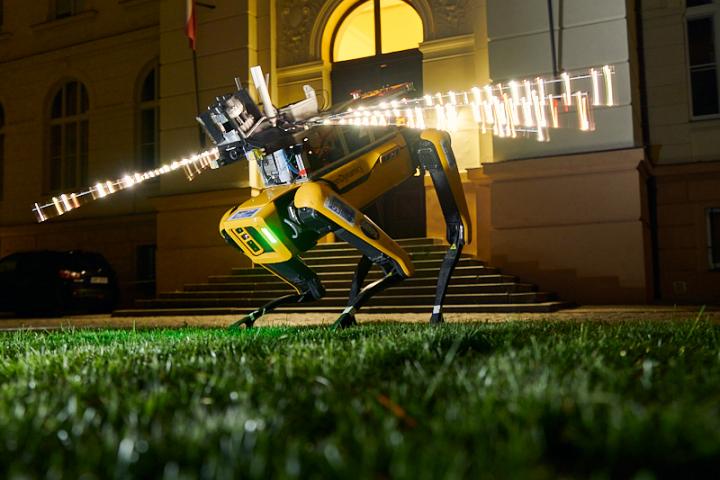
"It's going to be really fun! You'll see robots that light up based on your movement, and you'll understand how the robots see you through data visualisation on a screen. And maybe for the first time ever you will hear how the magnetic field around them sounds," invites Jiří Zemánek, curator of the Forum Robotum installation from the Department of Control Engineering at FEL CTU. "The installation is very playful at first glance, but we also wanted to show people that robots will be around us more and more often and can be our partners, not our competitors. They are often portrayed unnecessarily negatively in popular culture," said Dr. Jiří Zemánek, referring to science fiction films, which he said can sometimes induce fear of new technologies unnecessarily.
Not to be afraid of the unknown is also the message of the installation according to the designer Ing. arch. Petr Vacek, who is behind the design of the interactive elements. "Man perceives the machine with his senses and tries to see if his actions will evoke a response. This natural human ability to explore everything new by means of experiment leads to understanding and acceptance, banishing the fear of the unknown," explains Petr Vacek. Like the makers of robotic dogs and spiders, he was inspired by animal anatomy when creating the light exoskeletons. "The organs attached to the robots resemble the colourful scrubs of beetles or butterfly wings. Using them, the machines mirror their own interpretation of human movement in their vicinity," he says of the proposed mechanism.
The variability of the scrubs and the transfer of what the robot sees to the screen is subject to an automated process. The movement of the robots itself is then controlled by human operators using wireless controllers, which were specially commissioned for the installation by Ing. Tomáš Rouček from the Department of Computers and Ing. Bedřich Himmel from the Department of Cybernetics. They welcome the involvement in the creative project, even though the work on it differs from the usual tasks in the laboratory. "Art and science are quite different things. It was nice not to have a fixed goal to aim for," explains Tomáš Rouček.
In addition to the visual perception, the sound component of the installation is also significant. "We capture the electromagnetic waves of the robots and convert them into the audible spectrum. We used a sensor from electric guitar to do this. I myself was surprised by the rich soundscape that is hidden in the robot," says installation director MgA. Vojtěch Leischner, a PhD student at the Department of Computer Graphics and Interaction at FEL CTU.
The biggest challenge for the team was to integrate all the elements of the installation into one working organism. This consists of electromagnetic sensors, microcontrollers, several wireless modules, light control, lidar (laser distance sensors), data analysis, computer vision and human-computer interaction, in addition to the robots themselves. "Today's technologies are really very complex. What appears to be a simple thing at first glance contains a lot of different systems, buses and protocols in the background. Connecting them is key to creating such an installation - yet it is an invisible and often demanding job for researchers," says Jiří Zemánek of the daunting task ahead of them.
Experts from various fields were involved in the preparation of the Forum Robotum installation and together they created a work oscillating between science, technology and art. This interdisciplinarity was a welcome experience for the entire implementation team. "Interdisciplinary collaboration should be the standard, not something extra. It brings all involved new perspectives on their own discipline and understanding of what the work of others entails. It develops empathy and the ability to communicate one's own ideas," says Vojtěch Leischner of the benefits of FEL CTU's participation in the Signal Festival.
All of the presented technologies are used in research at FEL CTU and are also used in teaching. They will be encountered especially by students of Bachelor and Master study programmes in Open Computer Science or Cybernetics and Robotics.
Implementation team
Director: MgA. Vojtěch Leischner (katedra počítačové grafiky a interakce FEL ČVUT)
Concept author: Ing. arch. Petr Vacek
Curators: Ing. Jiří Zemánek, Ph.D. (katedra řídicí techniky FEL ČVUT), MgA. Daniel Burda (Signal Festival)
Production: Mgr. Karolína Poliaková (katedra počítačů FEL ČVUT), Jiří Cmunt (Signal Festival)
Festival coordinator: Ing. Tomáš Rouček (katedra počítačů FEL ČVUT), Ing. Bedřich Himmel (katedra kybernetiky FEL ČVUT)
Signal festival web: https://www.signalfestival.com/instalace/forum-robotum/
Photos for download: https://drive.google.com/drive/folders/18PCHN2x6gQyqDoz6fyDqHX32MvPzEY8t?usp=sharing